Legalization of Abortion: A Public Health Issue
VerifiedAdded on 2020/02/19
|5
|1044
|130
AI Summary
This assignment tackles the complex issue of abortion legalization within the U.S., presenting arguments for and against its legality. It delves into the ethical considerations surrounding abortion, including women's rights and human life. The essay also analyzes the public health aspects of legal abortion compared to childbirth, emphasizing safety and access to healthcare. Finally, it proposes policy recommendations aimed at ensuring safe and legal abortion access while respecting individual beliefs.
Contribute Materials
Your contribution can guide someone’s learning journey. Share your
documents today.
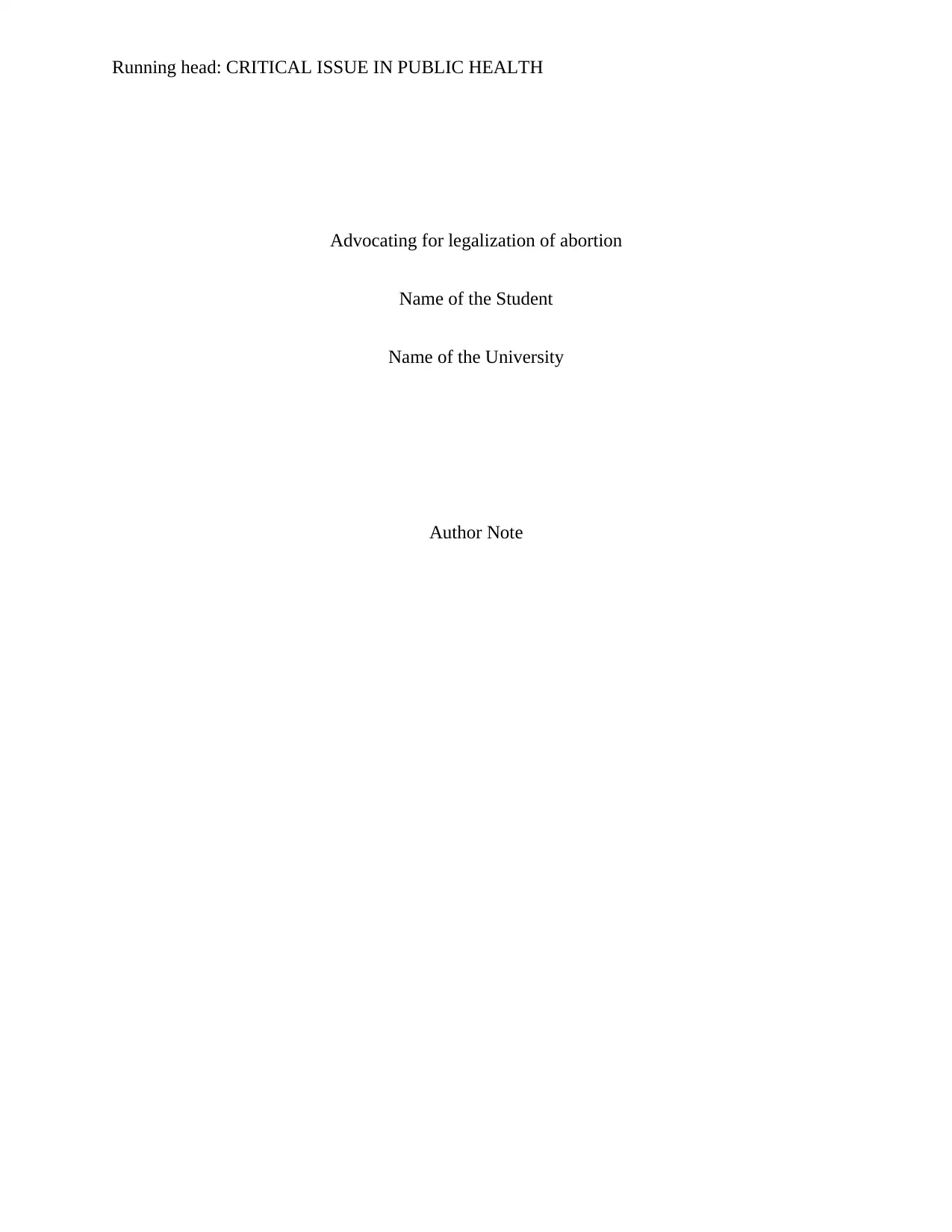
Running head: CRITICAL ISSUE IN PUBLIC HEALTH
Advocating for legalization of abortion
Name of the Student
Name of the University
Author Note
Advocating for legalization of abortion
Name of the Student
Name of the University
Author Note
Secure Best Marks with AI Grader
Need help grading? Try our AI Grader for instant feedback on your assignments.
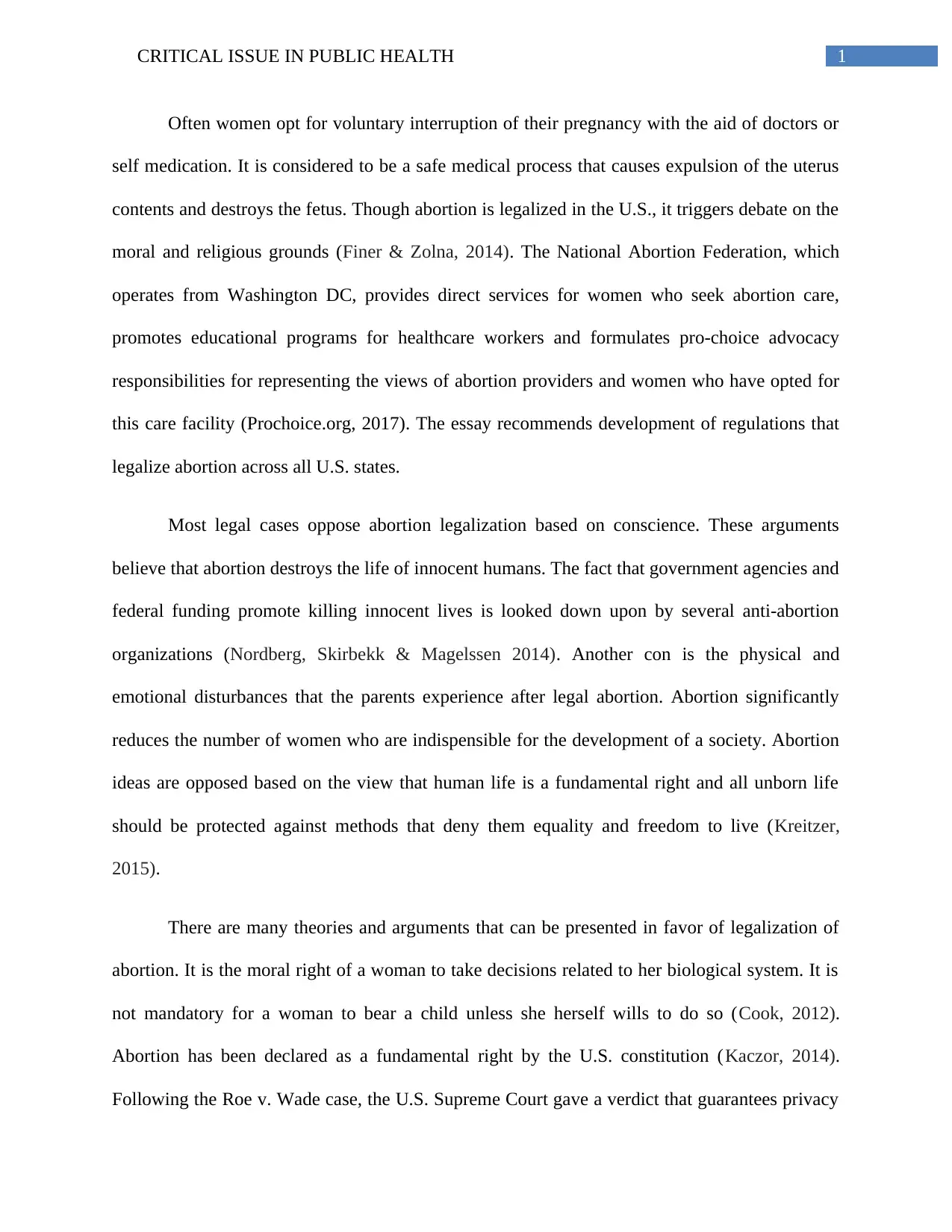
1CRITICAL ISSUE IN PUBLIC HEALTH
Often women opt for voluntary interruption of their pregnancy with the aid of doctors or
self medication. It is considered to be a safe medical process that causes expulsion of the uterus
contents and destroys the fetus. Though abortion is legalized in the U.S., it triggers debate on the
moral and religious grounds (Finer & Zolna, 2014). The National Abortion Federation, which
operates from Washington DC, provides direct services for women who seek abortion care,
promotes educational programs for healthcare workers and formulates pro-choice advocacy
responsibilities for representing the views of abortion providers and women who have opted for
this care facility (Prochoice.org, 2017). The essay recommends development of regulations that
legalize abortion across all U.S. states.
Most legal cases oppose abortion legalization based on conscience. These arguments
believe that abortion destroys the life of innocent humans. The fact that government agencies and
federal funding promote killing innocent lives is looked down upon by several anti-abortion
organizations (Nordberg, Skirbekk & Magelssen 2014). Another con is the physical and
emotional disturbances that the parents experience after legal abortion. Abortion significantly
reduces the number of women who are indispensible for the development of a society. Abortion
ideas are opposed based on the view that human life is a fundamental right and all unborn life
should be protected against methods that deny them equality and freedom to live (Kreitzer,
2015).
There are many theories and arguments that can be presented in favor of legalization of
abortion. It is the moral right of a woman to take decisions related to her biological system. It is
not mandatory for a woman to bear a child unless she herself wills to do so (Cook, 2012).
Abortion has been declared as a fundamental right by the U.S. constitution (Kaczor, 2014).
Following the Roe v. Wade case, the U.S. Supreme Court gave a verdict that guarantees privacy
Often women opt for voluntary interruption of their pregnancy with the aid of doctors or
self medication. It is considered to be a safe medical process that causes expulsion of the uterus
contents and destroys the fetus. Though abortion is legalized in the U.S., it triggers debate on the
moral and religious grounds (Finer & Zolna, 2014). The National Abortion Federation, which
operates from Washington DC, provides direct services for women who seek abortion care,
promotes educational programs for healthcare workers and formulates pro-choice advocacy
responsibilities for representing the views of abortion providers and women who have opted for
this care facility (Prochoice.org, 2017). The essay recommends development of regulations that
legalize abortion across all U.S. states.
Most legal cases oppose abortion legalization based on conscience. These arguments
believe that abortion destroys the life of innocent humans. The fact that government agencies and
federal funding promote killing innocent lives is looked down upon by several anti-abortion
organizations (Nordberg, Skirbekk & Magelssen 2014). Another con is the physical and
emotional disturbances that the parents experience after legal abortion. Abortion significantly
reduces the number of women who are indispensible for the development of a society. Abortion
ideas are opposed based on the view that human life is a fundamental right and all unborn life
should be protected against methods that deny them equality and freedom to live (Kreitzer,
2015).
There are many theories and arguments that can be presented in favor of legalization of
abortion. It is the moral right of a woman to take decisions related to her biological system. It is
not mandatory for a woman to bear a child unless she herself wills to do so (Cook, 2012).
Abortion has been declared as a fundamental right by the U.S. constitution (Kaczor, 2014).
Following the Roe v. Wade case, the U.S. Supreme Court gave a verdict that guarantees privacy
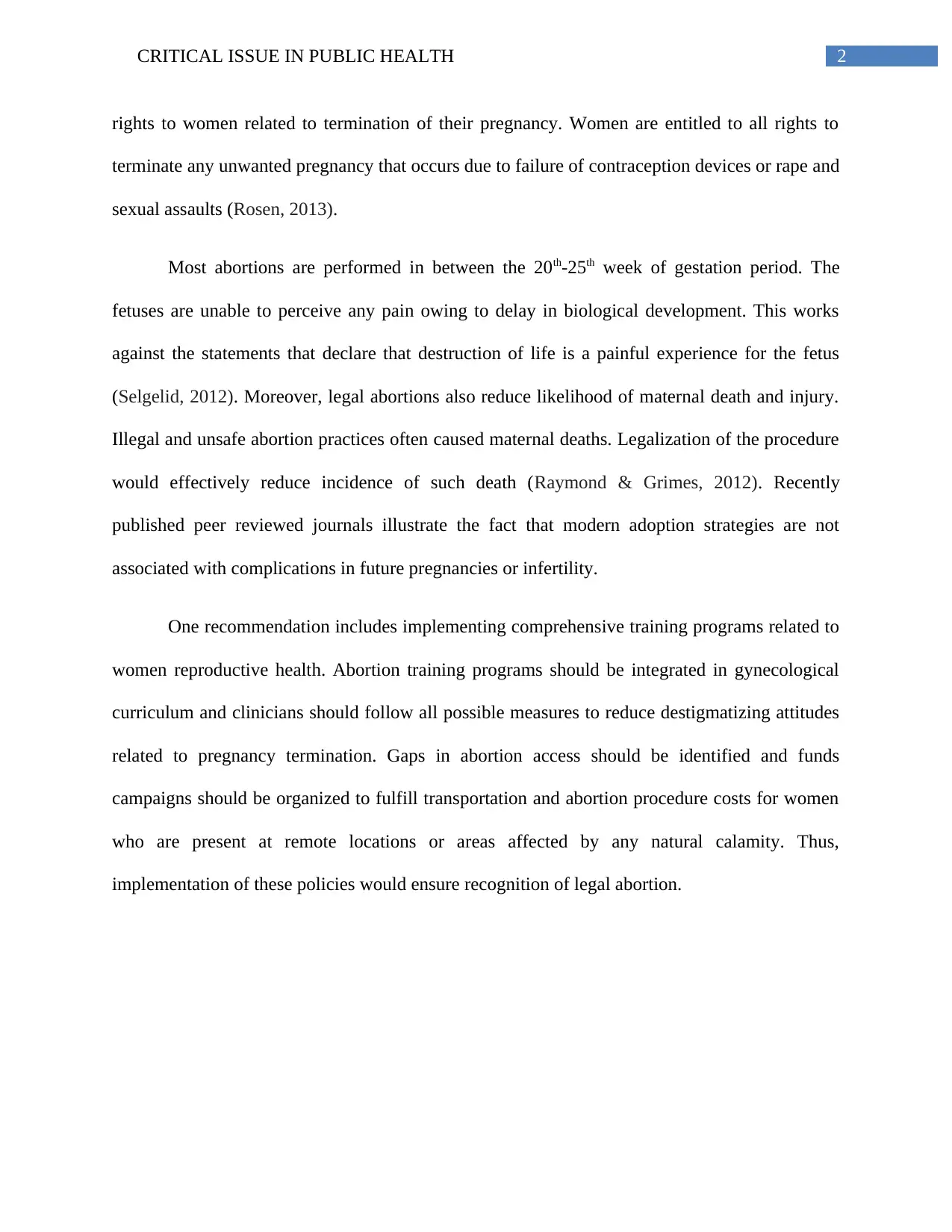
2CRITICAL ISSUE IN PUBLIC HEALTH
rights to women related to termination of their pregnancy. Women are entitled to all rights to
terminate any unwanted pregnancy that occurs due to failure of contraception devices or rape and
sexual assaults (Rosen, 2013).
Most abortions are performed in between the 20th-25th week of gestation period. The
fetuses are unable to perceive any pain owing to delay in biological development. This works
against the statements that declare that destruction of life is a painful experience for the fetus
(Selgelid, 2012). Moreover, legal abortions also reduce likelihood of maternal death and injury.
Illegal and unsafe abortion practices often caused maternal deaths. Legalization of the procedure
would effectively reduce incidence of such death (Raymond & Grimes, 2012). Recently
published peer reviewed journals illustrate the fact that modern adoption strategies are not
associated with complications in future pregnancies or infertility.
One recommendation includes implementing comprehensive training programs related to
women reproductive health. Abortion training programs should be integrated in gynecological
curriculum and clinicians should follow all possible measures to reduce destigmatizing attitudes
related to pregnancy termination. Gaps in abortion access should be identified and funds
campaigns should be organized to fulfill transportation and abortion procedure costs for women
who are present at remote locations or areas affected by any natural calamity. Thus,
implementation of these policies would ensure recognition of legal abortion.
rights to women related to termination of their pregnancy. Women are entitled to all rights to
terminate any unwanted pregnancy that occurs due to failure of contraception devices or rape and
sexual assaults (Rosen, 2013).
Most abortions are performed in between the 20th-25th week of gestation period. The
fetuses are unable to perceive any pain owing to delay in biological development. This works
against the statements that declare that destruction of life is a painful experience for the fetus
(Selgelid, 2012). Moreover, legal abortions also reduce likelihood of maternal death and injury.
Illegal and unsafe abortion practices often caused maternal deaths. Legalization of the procedure
would effectively reduce incidence of such death (Raymond & Grimes, 2012). Recently
published peer reviewed journals illustrate the fact that modern adoption strategies are not
associated with complications in future pregnancies or infertility.
One recommendation includes implementing comprehensive training programs related to
women reproductive health. Abortion training programs should be integrated in gynecological
curriculum and clinicians should follow all possible measures to reduce destigmatizing attitudes
related to pregnancy termination. Gaps in abortion access should be identified and funds
campaigns should be organized to fulfill transportation and abortion procedure costs for women
who are present at remote locations or areas affected by any natural calamity. Thus,
implementation of these policies would ensure recognition of legal abortion.
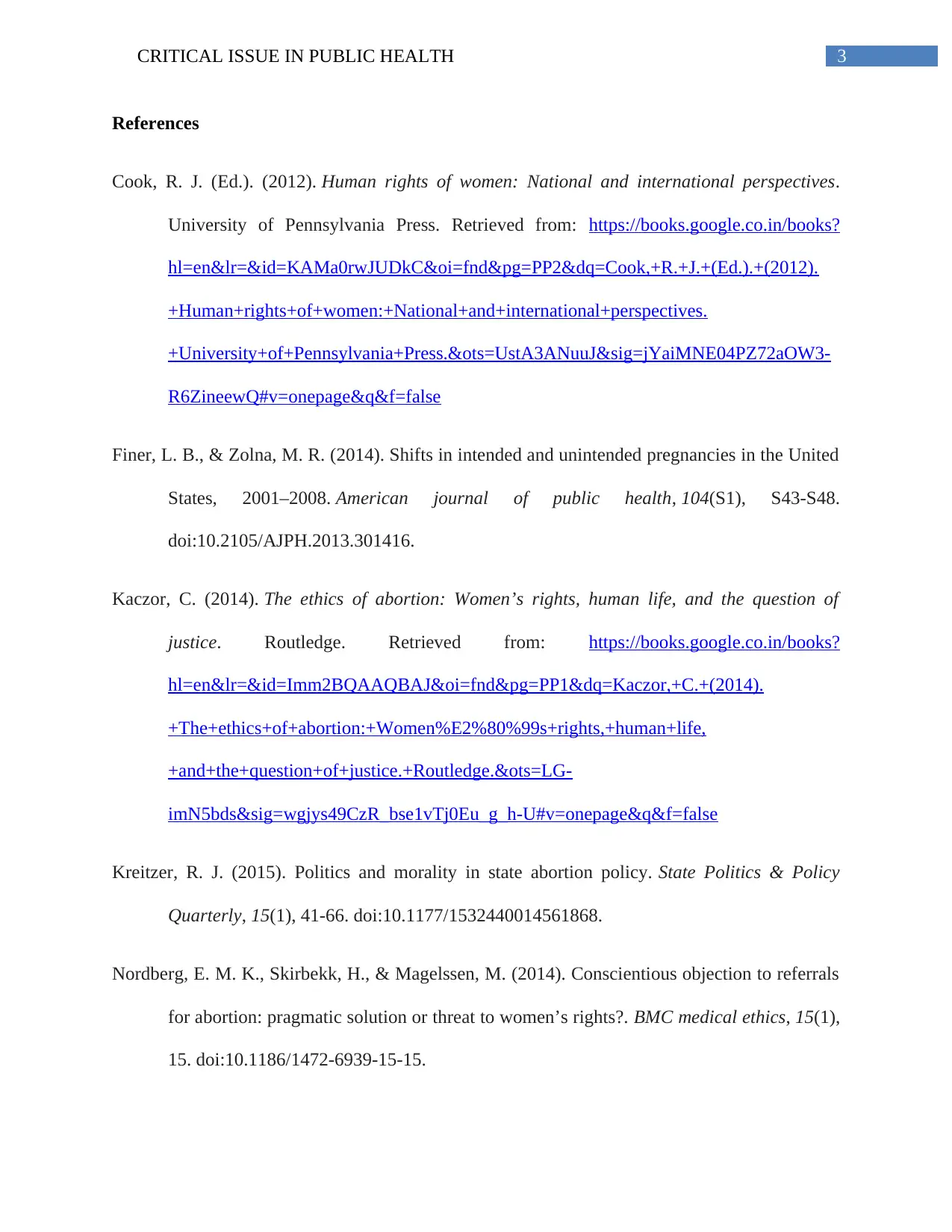
3CRITICAL ISSUE IN PUBLIC HEALTH
References
Cook, R. J. (Ed.). (2012). Human rights of women: National and international perspectives.
University of Pennsylvania Press. Retrieved from: https://books.google.co.in/books?
hl=en&lr=&id=KAMa0rwJUDkC&oi=fnd&pg=PP2&dq=Cook,+R.+J.+(Ed.).+(2012).
+Human+rights+of+women:+National+and+international+perspectives.
+University+of+Pennsylvania+Press.&ots=UstA3ANuuJ&sig=jYaiMNE04PZ72aOW3-
R6ZineewQ#v=onepage&q&f=false
Finer, L. B., & Zolna, M. R. (2014). Shifts in intended and unintended pregnancies in the United
States, 2001–2008. American journal of public health, 104(S1), S43-S48.
doi:10.2105/AJPH.2013.301416.
Kaczor, C. (2014). The ethics of abortion: Women’s rights, human life, and the question of
justice. Routledge. Retrieved from: https://books.google.co.in/books?
hl=en&lr=&id=Imm2BQAAQBAJ&oi=fnd&pg=PP1&dq=Kaczor,+C.+(2014).
+The+ethics+of+abortion:+Women%E2%80%99s+rights,+human+life,
+and+the+question+of+justice.+Routledge.&ots=LG-
imN5bds&sig=wgjys49CzR_bse1vTj0Eu_g_h-U#v=onepage&q&f=false
Kreitzer, R. J. (2015). Politics and morality in state abortion policy. State Politics & Policy
Quarterly, 15(1), 41-66. doi:10.1177/1532440014561868.
Nordberg, E. M. K., Skirbekk, H., & Magelssen, M. (2014). Conscientious objection to referrals
for abortion: pragmatic solution or threat to women’s rights?. BMC medical ethics, 15(1),
15. doi:10.1186/1472-6939-15-15.
References
Cook, R. J. (Ed.). (2012). Human rights of women: National and international perspectives.
University of Pennsylvania Press. Retrieved from: https://books.google.co.in/books?
hl=en&lr=&id=KAMa0rwJUDkC&oi=fnd&pg=PP2&dq=Cook,+R.+J.+(Ed.).+(2012).
+Human+rights+of+women:+National+and+international+perspectives.
+University+of+Pennsylvania+Press.&ots=UstA3ANuuJ&sig=jYaiMNE04PZ72aOW3-
R6ZineewQ#v=onepage&q&f=false
Finer, L. B., & Zolna, M. R. (2014). Shifts in intended and unintended pregnancies in the United
States, 2001–2008. American journal of public health, 104(S1), S43-S48.
doi:10.2105/AJPH.2013.301416.
Kaczor, C. (2014). The ethics of abortion: Women’s rights, human life, and the question of
justice. Routledge. Retrieved from: https://books.google.co.in/books?
hl=en&lr=&id=Imm2BQAAQBAJ&oi=fnd&pg=PP1&dq=Kaczor,+C.+(2014).
+The+ethics+of+abortion:+Women%E2%80%99s+rights,+human+life,
+and+the+question+of+justice.+Routledge.&ots=LG-
imN5bds&sig=wgjys49CzR_bse1vTj0Eu_g_h-U#v=onepage&q&f=false
Kreitzer, R. J. (2015). Politics and morality in state abortion policy. State Politics & Policy
Quarterly, 15(1), 41-66. doi:10.1177/1532440014561868.
Nordberg, E. M. K., Skirbekk, H., & Magelssen, M. (2014). Conscientious objection to referrals
for abortion: pragmatic solution or threat to women’s rights?. BMC medical ethics, 15(1),
15. doi:10.1186/1472-6939-15-15.
Secure Best Marks with AI Grader
Need help grading? Try our AI Grader for instant feedback on your assignments.
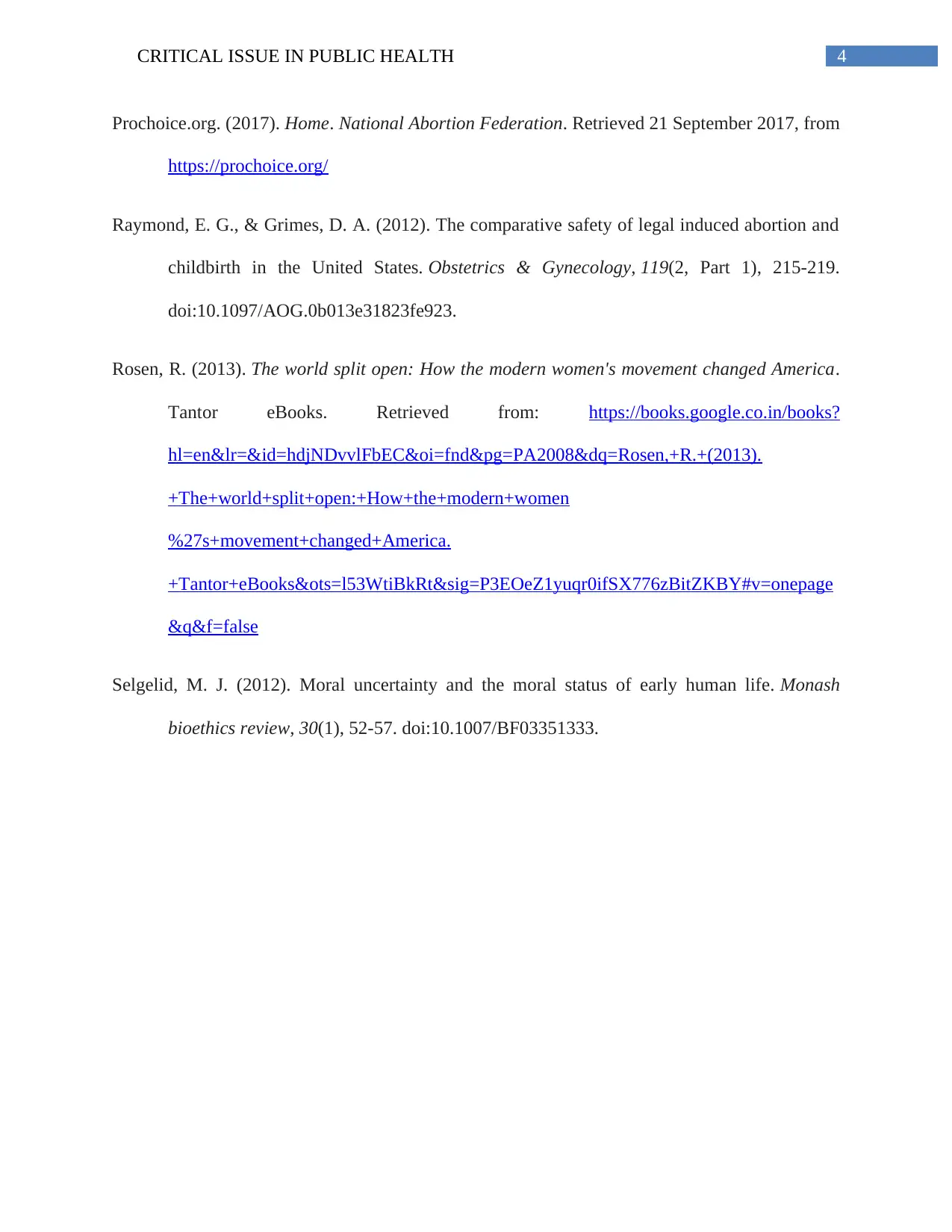
4CRITICAL ISSUE IN PUBLIC HEALTH
Prochoice.org. (2017). Home. National Abortion Federation. Retrieved 21 September 2017, from
https://prochoice.org/
Raymond, E. G., & Grimes, D. A. (2012). The comparative safety of legal induced abortion and
childbirth in the United States. Obstetrics & Gynecology, 119(2, Part 1), 215-219.
doi:10.1097/AOG.0b013e31823fe923.
Rosen, R. (2013). The world split open: How the modern women's movement changed America.
Tantor eBooks. Retrieved from: https://books.google.co.in/books?
hl=en&lr=&id=hdjNDvvlFbEC&oi=fnd&pg=PA2008&dq=Rosen,+R.+(2013).
+The+world+split+open:+How+the+modern+women
%27s+movement+changed+America.
+Tantor+eBooks&ots=l53WtiBkRt&sig=P3EOeZ1yuqr0ifSX776zBitZKBY#v=onepage
&q&f=false
Selgelid, M. J. (2012). Moral uncertainty and the moral status of early human life. Monash
bioethics review, 30(1), 52-57. doi:10.1007/BF03351333.
Prochoice.org. (2017). Home. National Abortion Federation. Retrieved 21 September 2017, from
https://prochoice.org/
Raymond, E. G., & Grimes, D. A. (2012). The comparative safety of legal induced abortion and
childbirth in the United States. Obstetrics & Gynecology, 119(2, Part 1), 215-219.
doi:10.1097/AOG.0b013e31823fe923.
Rosen, R. (2013). The world split open: How the modern women's movement changed America.
Tantor eBooks. Retrieved from: https://books.google.co.in/books?
hl=en&lr=&id=hdjNDvvlFbEC&oi=fnd&pg=PA2008&dq=Rosen,+R.+(2013).
+The+world+split+open:+How+the+modern+women
%27s+movement+changed+America.
+Tantor+eBooks&ots=l53WtiBkRt&sig=P3EOeZ1yuqr0ifSX776zBitZKBY#v=onepage
&q&f=false
Selgelid, M. J. (2012). Moral uncertainty and the moral status of early human life. Monash
bioethics review, 30(1), 52-57. doi:10.1007/BF03351333.
1 out of 5
Your All-in-One AI-Powered Toolkit for Academic Success.
+13062052269
info@desklib.com
Available 24*7 on WhatsApp / Email
![[object Object]](/_next/static/media/star-bottom.7253800d.svg)
Unlock your academic potential
© 2024 | Zucol Services PVT LTD | All rights reserved.


